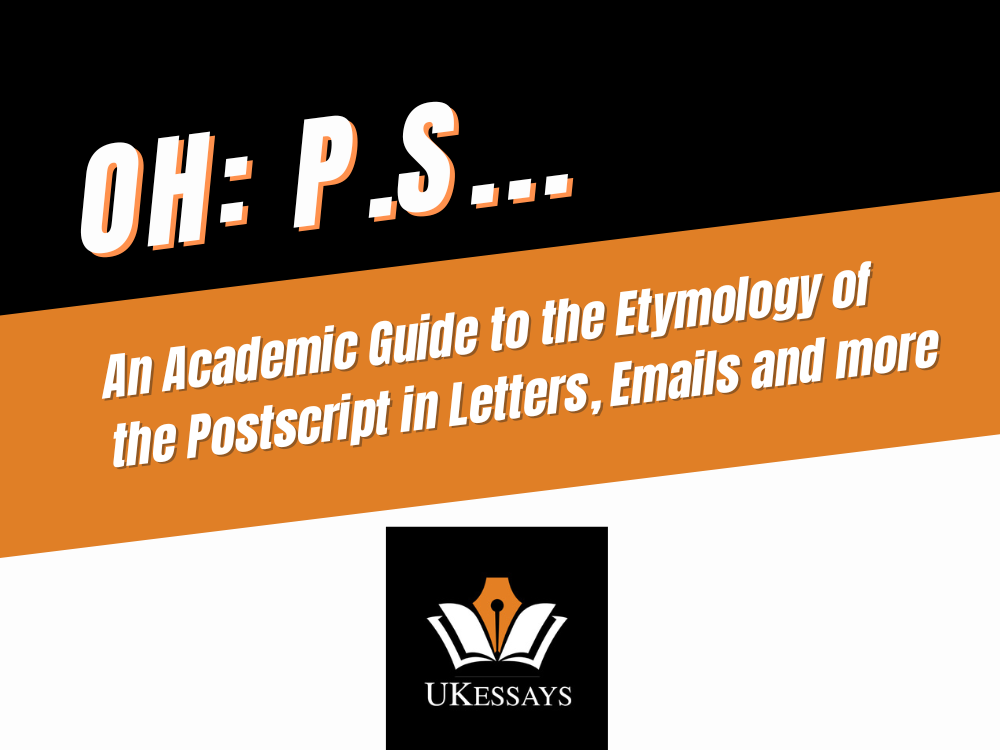Postscript (PS) in Letter Writing: An Academic Guide
Info: 2542 words (10 pages) Study Guides
Published: 24 Mar 2025
What is PS?
PS stands for postscript, from the Latin post scriptum meaning “written after.” In traditional letter writing, a postscript is an additional note one adds after the signature of a letter. It usually contains an afterthought or extra information that didn’t make it into the main body of the letter. The introduction of the PS often occurs with the letters “PS” (or “P.S.”) followed by a brief message. Essentially, it is the writer’s way of saying, “One more thing…” after concluding the main text. This summary gives a quick answer: PS is an appended message at the end of a letter, used to add a final thought or detail after the main letter is finished.

Origins and Evolution of PS in Letter Writing
Historical origins
The use of postscripts in letters dates back centuries. The Oxford English Dictionary defines a postscript as “a paragraph written at the end of a letter, after the signature, containing an afterthought or additional matter.” The earliest recorded use of “PS” in English is attributed to a 1523 letter by Cardinal Thomas Wolsey, advisor to King Henry VIII. He describes the inclusion of a postscript as “right expedient” (i.e. very useful).
In an era of expensive paper and handwritten letters, adding a postscript was a practical solution. In essence, writers could include a forgotten point without rewriting the entire letter. This practical origin is reflected in the Latin roots of post scriptum (“written after”), indicating something written after the main text.
Early usage and purpose
Letter correspondences from the 16th century show postscripts used to convey small additional messages, such as personal regards or minor instructions that came to mind late in the writing process.
In early modern letter-writing, a PS often truly was a genuine afterthought. For example, a quick extra request or greeting you add after signing the letter.
However, writers soon discovered the stylistic potential of the postscript. Sometimes the postscript was used to emphasise a key point, even one as important as or more important than anything in the main body of the letter. For instance, the 17th-century philosopher Francis Bacon noted a cunning tactic: one letter-writer “would put that which was most material in the post-script, as if it had been a by-matter.” In other words, it was possible to hide a crucial message in the PS to draw attention or to create a certain rhetorical effect, almost like a strategic afterthought.
Evolution over time
Through the eighteenth and nineteenth centuries, the PS became an established convention in personal and business correspondence. It was often regarded as a charming or witty addition to a letter. By the 18th century, postscripts were common enough to be considered a stylistic flourish. One literary review calls the postscript a place for a writer’s “dangerous logic” – an area to play with meaning after the main text.
As letter-writing evolved, many letter-writing manuals and etiquette guides included the postscript as a standard element of a letter’s format (typically placed below the signature). The practice continued into the typewriting era: even when letters became easier to re-type, people still added “P.S.” lines, sometimes out of habit or to inject personality or emphasis at the end of a message.
Technological impact
The necessity of the PS began to decline with modern technology. Once word processors and computers became common, writers could easily scroll back and insert additional information into the body of a document. This reduced the practical need for postscripts purely as afterthoughts. By the late 20th century, style guides started to consider the postscript an optional or even old-fashioned device. For example, the Chicago Manual of Style notes that postscripts are “a little old-fashioned” now that one can edit a document easily
What was once born out of practical need has become more of a stylistic choice. In summary, the PS has evolved from a practical workaround in the age of pen and paper to a rhetorical and stylistic tool in modern writing.
Modern Usage of PS in Digital Communication
PS in emails, texts, and online messages
In today’s digital era, one might think the postscript would disappear – after all, with emails and messaging apps, you can simply update the text before sending. Indeed, some writing experts argue a postscript “makes no sense in an email context” because you can edit the email draft instead. Despite this, PS still appears in digital communications, though its role is more deliberate and stylistic than necessary.
Emails
In personal emails, people sometimes add “PS” at the end to inject a last-minute thought or a light-hearted comment. In professional or marketing emails, a PS can serve as a way to highlight a key message or call-to-action. Communications experts note that readers often skim content, paying attention to the beginning and the end. Thus, marketers often use a PS to restate an offer or important point, knowing it’s likely to catch the reader’s eye. For example, a fundraising email might conclude with “PS: Even a small contribution helps us reach our goal,” to reinforce the request. This practice echoes the sales letters of the past where the postscript was a final persuasive pitch.
Text messages and social media
In instant messaging or texts, a true postscript is less common (since one can just send another message). However, some people use the “PS” convention in longer posts or messages on social media for a humorous or emphasis effect. For instance, a person might write a lengthy Facebook update and end with “P.S. I really do miss all of you!” to add a personal aside.
On platforms like Twitter (or X) and Instagram captions, “PS” is an occasional as a stylistic add-on to convey a side note or afterthought in a single post. In these cases, PS is functioning as a storytelling or emphasis tool rather than a needed addition – it deliberately draws the reader’s attention by breaking the expected structure of the message.
Common mistakes and considerations in modern usage
Because the postscript isn’t strictly necessary in digital writing, its misuse can stand out. Here are some common mistakes or misconceptions about using PS today, and how to avoid them:
Using PS for essential information
In formal digital communication, do not relegate critical information to a PS. If something is important for the reader, it belongs in the main body of your email or message (or perhaps as a clearly labelled note), rather than as a seemingly last-minute addition. Overusing PS in professional emails can make it appear that you forgot to plan your message, which may seem unprofessional.
Multiple postscripts (PPS, PPPS)
If you have more than one extra point, the convention is to use PPS (post-postscript) for a second postscript, PPPS for a third, and so on. A common mistake is writing “PSS” for a second postscript, but this is incorrect. The correct sequence is PS, PPS, PPPS.
In practice, however, using multiple postscripts gives the appearance that you didn’t organise your email or letter well. It’s often better to integrate those points into the main text or send a follow-up message if needed.
Placement and format
A postscript should always come after the signature or sender’s name in a letter or email. Writing “PS” before you’ve even signed off defeats the purpose – by definition, it comes post- (after) the script. In emails, if you include a professional email signature block, the PS would typically appear below that block. Also, keep the PS concise. It’s meant to be a brief afterthought or note, so one or two sentences at most is standard. A postscript that rambles on at length could be confusing or easily overlooked.
Punctuation and style
Both “PS” and “P.S.” are widely accepted formats for the abbreviation. Modern style guides tend to prefer “PS” without periods for simplicity, especially in UK English. (For instance, Cambridge University Press’s guide suggests “PS” as the British English form. Meanwhile, “P.S.” with full stops is more common in American style.) Whichever format you choose, use it consistently. After the letters, add either no punctuation or a colon. For example, consider the following of “PS: Here is a final note.”
Many writers find that using a colon after “PS” visually separates it from the rest of the text. This makes it clear that what follows is a postscript.
In summary, in digital communication a PS should be used sparingly and purposefully. If used correctly, it can add a personal touch or draw attention to a key point. If used carelessly, it can appear out-of-place or sloppy in an age where editing text is easy.
PS in Academic and Formal Writing
When it comes to academic and highly formal writing, the standards for using a postscript are much stricter. In general, postscripts are rare in formal academic or professional documents. The expectation in such contexts is that the writing will be carefully planned and revised, eliminating the need for afterthoughts at the end. As one writing expert notes, in formal communication the recipient “expects you to think before you mail your message.” In essence, adding afterthoughts later (as a PS) can make the writer seem disorganised or unprofessional
writing.stackexchange.com. In business letters or job applications, for example, including a PS can be seen as a breach of formal style unless done for a very specific purpose.
Academic writing
In scholarly articles, essays, or reports, you will almost never find a “P.S.” at the end. If an author or researcher has an additional note or aside, it is typically included as a footnote, endnote, or an appendix, rather than a postscript. Academic writing values a well-structured approach. Any extra remarks should be integrated into the main text or properly cited in notes. Even in less formal academic communications (like an email to a lecturer or a cover letter for a graduate program application), it’s advisable to avoid postscripts.
If you forgot to mention something, it is better to edit the draft or write a brief follow-up message, rather than sticking a PS in a formal email. The postscript in academia might only appear in a metaphorical sense. For example, an author might title a brief concluding section of a book as a “Postscript” to indicate it’s a later addition or reflection, but this is part of the planned content, not an impromptu add-on.
Formal letters
Traditional formal letter formats (such as business letters) do allow for a postscript, but it is used sparingly. A postscript in a formal letter might be appropriate if you want to add a short, personal note to an otherwise impersonal communication. For instance, thanking the reader once more, or adding a scheduling reminder (“PS. I look forward to discussing this in person on Tuesday”). However, even this should be done with caution. Many style guides suggest that if a detail is important enough to mention, it should be in the body of the letter.
A training resource on professional correspondence emphasises adding a postscript only after the sign-off and notes that it’s often unnecessary in formal letters. In other words, use a PS in formal letters only when:
- it genuinely adds value or a human touch and;
- does not introduce critical new information.
It’s worth noting that some business and marketing experts deliberately use postscripts in formal proposals or cover letters as a technique to draw attention. That’s because a PS stands out on the page. For example, a job seeker might cheekily add, “P.S. I’ve attached a portfolio sample that shows the quality of work I could bring to your team.”
This can work as a way to be memorable, but it’s a risky strategy in very formal situations. Many hiring managers or academics would prefer a well-structured letter over one with a playful postscript. So, the safest advice for students and professionals is: when writing in academic or strict professional contexts, it’s usually best to omit the PS unless you have a specific, strategic reason to include it.
Conclusion: The Role of PS Today
The postscript has an enduring place in written communication, straddling the line between practical utility and stylistic flourish. Historically, it solved a practical problem in letter writing – allowing writers to append thoughts without starting over – and over time it also became a rhetorical device, used to surprise, emphasise, or add a personal touch.
In the modern world of instantaneous editing and digital messaging, the PS is no longer necessary from a technical standpoint, but it has not disappeared. Instead, it has adapted: we now use postscripts strategically to highlight information or inject personality into our messages.
For undergraduate and postgraduate students, understanding the proper use of “PS” is part of learning effective writing etiquette. In informal or personal communications, a PS can convey warmth or humour. In marketing, it can draw the eye to a call-to-action. But in academic essays or formal emails, a PS may be out of place.
Thus, to use a postscript well is to know your context: include one as a conscious choice, not by accident. When used appropriately, that little “PS” can be the most memorable part of a letter – “the wink you give as you walk away,” as one letters anthology author famously said. But when misused, it can distract or detract from your message. This guide has provided a comprehensive overview of PS usage across history and into the digital age, equipping you to decide when a postscript is a charming addition and when it’s better left unwritten.
References
- Bacon, F. (1625). Of Cunning – Observation on Postscripts. (Quoted in Wealden Wordsmith) – Francis Bacon notes the strategy of hiding important points in a postscript.
- Bess of Hardwick’s Letters (16th century). Correspondence 1550–1608 – Examples of Postscripts. Edited historical letters showing placement and use of postscripts.
- Chicago Manual of Style (2017). Abbreviations: Postscripts. Chicago Manual of Style Online, 17th ed. – Style Note on “PS” (postscripts old-fashioned; recommends “PS” without periods).
- Nordquist, R. (2019). Postscript (P.S.) Definition and Examples in Writing. ThoughtCo. – Definition and Usage (general overview; notes on business letters using PS).
- Paul Brians (2016). Common Errors in English Usage: “PPS”. Washington State University – Correct Use of PPS vs P.S. (clarifies that second postscript is “PPS”, not “PSS”).
- Pemberly Fox (2023). How to Write a Letter – Step 10: Postscript. Pemberly Fox Journal – Letter Writing Guide (advises PS as optional, not usually needed in formal letters).
- Stack Exchange (2013). Writing StackExchange: Using P.S. in a formal email. – Expert Answer (argues PS is unnecessary in emails due to editing capability).
- Stack Exchange (2021). Writing StackExchange: Postscript Usage. – Accepted Answer (explains postscripts are obsolete in formal writing and may seem unprofessional).
- Wealden Wordsmith (2020). Just One More Thing: The Power of the Postscript by C. Guiton. – Historical Insights & Modern Perspective (OED definition; 1523 Wolsey reference; quote about PS as “the wink… as you walk away”; marketing usage in emails).
- Oxford English Dictionary (OED) (n.d.). Entry for “postscript”. – Definition (as cited in Wealden Wordsmith). The OED provides the formal definition of a postscript in correspondence.
- Cambridge Dictionary (n.d.). Usage note on PS/P.S. – UK vs US Style (British English tends to use “PS” without dots, American English often uses “P.S.”)
Cite This Work
To export a reference to this article please select a referencing stye below:



